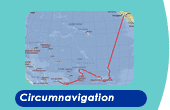











Mediterranean Massacre
Richard Ellis 01/10/2003
Seeing bluefin tuna gaffed is like watching a thoroughbred racehorse being hacked to death with an axe.
‘The bluefin were to ancient Mediterranean peoples what the buffalo were to the American plains Indian,’ writes Theresa Maggio in her brilliant little book Mattanza. The book charts the history of Sicily’s annual tuna harvests, or tonnara, from the time of the Carthaginians and Phoenicians five centuries before Christ right up to the present day. (Mattanza is an Italian word that means ‘killing’.) Maggio describes tuna fishing as ‘a yearly miracle, a reliable source of protein from a giant animal [the people of the Mediterranean] revered, one that passed in such numbers that the cooperation of an entire tribe was needed to kill and preserve [its] meat’. ‘Around the Mediterranean,’ says Maggio, ‘the migrating bluefin was a staple food for entire civilisations.’
Describing the second-century tonnara in Halieutica, the Greek poet and naturalist Oppian wrote: ‘Dropped in the water are nets arranged like a city. There are rooms and gates and deep tunnels and atria and courtyards. The tuna arrive in great haste, drawn together like a phalanx of men who march in rank. There are the young, the old, the adults. And they swim, innumerable, inside the nets, and the movement is stopped only when there is no more room for new arrivals. Then the net is pulled up and a rich haul of excellent tuna is made.’
Today, there are only two mattanza remaining. The more famous of the two is that of the village of Favignana, which is located on one of the Egadi islands off the western tip of Sicily. The Favignana fishermen deploy a complex arrangement of gigantic nets along the tunas’ expected route, and wait for the great fish to swim into them. Maggio says the trap used at Favignana ‘is divided into seven rooms by net walls with gates in them’; it is ‘50 meters squared’. The last ‘room’ the tuna will ever see is the camera della morte (the ‘chamber of death’), the only room with a net bottom, and which the tonnaroti raise by hand from 75-foot-long open boats.
Jacques Cousteau described his experience in a Tunisian tuna net in his 1953 book The Silent World. The Tunisian death chamber is called a corpo. Cousteau wrote: ‘Marcel Ichac filmed the spectacle from a boat above the corpo, while Dumas and I dived into the net to record it below.
‘Sunk in the crystalline water we could not see both sidewalls of the corpo, and imagined that the fish could not, either. We had unconsciously taken on the psyche of the doomed animals.
‘In the frosty green space we saw the herd only occasionally. The noble fish, weighing up to 400 pounds apiece, swam around and around counter-clockwise, according to their habit. In contrast to their might, the net wall looked like a spider web that would rend before their charge, but they did not challenge it.
‘Above the surface, the Arabs were shrinking the walls of the corpo, and the rising floor came into view… The death chamber was reduced to a third of its size. The atmosphere grew excited, frantic. The herd swam restlessly faster, but still in formation. Their eyes passed us with almost human expressions of fright.
‘My final dive came just before the boatmen tied off the corpo to begin the killing. Never have I beheld a sight like the death cell in the last moments. In a space comparable to a large living room tunas and bonitos drove madly in all directions. It took all my will power to stay down and hold the camera… With the seeming momentum of locomotives, the tuna drove at me, head-on, obliquely and crosswise. It was out of the question for me to dodge them. Frightened out of sense of time, I heard the reel run out and surfaced amidst the thrashing bodies. There was not a mark on my body. Even while running amok the giant fish had avoided me by inches, merely massaging me with backwash when they sped past.
‘The fishermen struck at the surfaced swarm with large gaffs. The sea turned red. It took five or six men whacking gaffs into a single tuna to draw it out, flapping and bending like a gross mechanical toy. The boats rocked with convulsive bleeding mounds of tuna and bonitos.’
I have never seen a mattanza myself, but I have seen films of the ritual. The sight of sleek and graceful bluefins being gaffed is heartbreaking. One moment they are on what Cousteau called their ‘honeymoon’, and the next they are thrashing in a panicked mêlée as heavy steel hooks are smashed into their bodies and they are hauled ignominiously from the only element they have ever known into the one where they will die. Bluefins are among the most powerful and beautiful of the oceans’ top predators, and seeing them gaffed is like watching a thoroughbred racehorse being hacked to death with an axe.
Decline of an industry, death of a fish
The tonnare once constituted one of Sicily’s most important and profitable industries. But diminishing numbers of tuna and market laws that have made the practice more capital-intensive mean there are only about 10 tonnare left in the Mediterranean. What was once a source of pride (not to mention income) for entire communities has now turned into a tourist attraction, providing a few makeshift jobs. The practice is only kept alive by the obstinate will of the remaining tonnaroti. Almost all of the tuna caught in Favignana is shipped to Japan; all of Sicily‘s canneries have closed.
Facing extinction
Factory ships, 100 mile long fishing lines, nets larger than the Millennium Dome – can the bluefin tuna survive?
Sicily’s tonnare may have been brutal, but they were nothing compared to what has taken their place. Over the last 30 years, ever more industrialised fishing practices have drained the seas of fish in volumes that make the mattanza seem as intensive as bouncing a ping-pong ball into a bowl at the fairground. Nets wide enough to encircle the Millennium Dome, fishing lines 100 miles long with thousands of hooks that catch not just tuna, but sharks, seals, albatrosses and anything else unfortunate enough to be lured towards them, doppler counters to detect changes in the water‘s movement and even satellites spotting shoals of fish from space have all played their part in emptying the oceans of their once bountiful life.
Despite years of awareness of the impact of modern fisheries, despite countless organisations devoted to protecting fishing stocks, despite apparently increased consumer interest in environmentally sustainable food, the trend for intensification shows no sign of abating. Rather, a loophole big enough to drive a factory ship through has been discovered in the regulations governing Mediterranean bluefin tuna fishing, and it could signal the total extinction of the Mediterranean’s bluefin population within a few years.
While there are strict quotas on the number of fish that can be caught in nets or by harpoons, there are no regulations whatsoever applied to the practice of ‘post-harvesting’. The latter involves catching wild tuna and keeping them in pens before they are slaughtered. There are post-harvesting ‘farms’ in the waters off Spain, Italy, Malta and Croatia. These farms accounted for 11,000 tons of tuna caught in 2001. (Over the same period, the haul from direct fishing in the whole of the Mediterranean was 24,000 tons.)
More than 90 per cent of the post-harvested tuna goes to Japan. The appetite of the Japanese for tuna belly-meat is insatiable. ‘If nothing is done,’ says Paolo Guglielmi of the WWF‘s Mediterranean Programme, ‘wild bluefin tuna will completely disappear from the Mediterranean.’
Post-harvesting has completely reshaped fishing in the Mediterranean, and the fish are much the worse for it. Not only are the tuna threatened, but the fish caught to feed them while they are in the pens are also being fished to destruction. Almost all the countries that fish for tuna in the Mediterranean are switching over to farming. In each country the purse seine catches have declined while the total catch has increased. The entire catch of the Croatian tuna fleet (increased from 19 boats in 1999 to 30 in 2000) consists of undersized fish destined for the pens.
The WWF says: ‘In the Mediterranean tuna farming started just a few years ago, but estimated production in 2001 gives an indication of the huge development of this activity in the region. Production in the Mediterranean is likely to make up more than half of the world total and is almost exclusively destined for the Japanese market.’
Last year Sergi Tudela, project coordinator of the WWF‘s Mediterranean Programme, wrote: ‘All the usual ingredients are there in the case of tuna-fattening farms: privatisation of a common good (in this case, with the added risk of its probable destruction in the short- to medium-term); concentration of the benefits into a few hands; public aid provided to pillage a natural resource; dispossession of the traditional resource users; social and economic deconstruction of the traditional fishing sector; complete lack of a regulatory framework; connivance of the administration; ineffectiveness of international supra-statal organisations; and growing demand for the product from a powerful market’.
The practice of post-harvesting seems to have originated a world away from the Mediterranean, in Port Lincoln, South Australia, where the southern bluefin is caught and raised – again primarily for the Japanese market. Kiwi White, a pilot for the South Australian Tuna Association, says: ‘The whole tuna industry now concentrates on catching fresh fish in the wild, transferring the live fish to huge floating cages and then towing these cages with up to 100 tonnes of live fish hundreds of miles back to our home port.
‘The fish are fed twice a day on pilchards, and each cage requires three or four divers to clean out the dead fish, repair any holes, etcetera… The tuna boat operators have a supply of fat healthy tuna in the bay, so when the fish are needed in Japan a team is sent out to harvest, kill and prepare them to be air-freighted. These fish command huge prices – up to $50 a kilogramme, and they have been the saviour of the fishing industry in Port Lincoln. Many people are now employed, and the owners are building huge mansions, driving the latest Mercedes and spending large amounts around our town.’
Good for the fishermen, not so good for the fish. In April 1996 South Australia’s tuna industry was crippled by a fierce storm that caused the deaths of thousands of captive fish that would have been worth more than $55m. The fish, which were kept in floating pens and were unable to escape the storm, were suffocated as their gills became clogged in swirling clouds of silt, excreta and sediment. Between 65,000 and 75,000 tuna died.
The mass deaths were a serious setback, but evidently not a lasting one for the booming Port Lincoln tuna-farm industry, which has grown at a phenomenal rate since the first experimental farm was established in 1991. The $100m fish-fattening industry now produces a whopping 60 per cent of the Australian tuna industry‘s 5,200-ton annual quota.
Even though post-harvesting is classified as ‘aquaculture‘, the fish are all wild-caught – just as if they had been harpooned or purse-seined. In true aquaculture, as is the case with Atlantic salmon, fish are raised from eggs, not simply moved from one place to another to be fattened. Nevertheless, the Australian and Mediterranean systems of tuna fattening demonstrate all the ills of legitimate aquaculture. The carnivorous tuna are fed large quantities of small fishes, which themselves may be threatened by over-collecting. Thus this kind of ‘farming’ does not relieve commercial fishing pressure – it increases it. Waste from the pens is another problem, as is their location – close enough to shore and urban centres to disrupt and often pollute the littoral zone. And because tuna farming falls between the definition of a fishery and true aquaculture, it is completely unregulated on a world scale.
Farmed for the madding crowd
Now, tuna farming has arrived in Mexico. In an article in The New York Times last year RW Apple wrote about the ‘new kind of mariculture’ that was taking place off the Pacific coast of Baja California. Mexican fishermen net young bluefins and tow them to special enclosures where the fish are kept in circular pens and fed live sardines three times a day for six to eight months. When they reach a weight of about 190 pounds, the fish are killed and frozen – mostly to feed Japan’s appetite for fatty tuna. ‘Despite the lasting slump in the Japanese economy,’ wrote Apple, ‘the meat sells for as much as $45 a pound.’
‘The next step in the transaction,’ says conservationist Carl Safina, ‘is a one-way air- freight ticket to Tokyo.’ The same is true of the Mediterranean bluefins, whose future is written in Japanese. The most beautiful fish in the world is being eaten out of existence as it has the misfortune of being one of the ‘most desirable food fishes’. Prices rise as the fishes’ numbers diminish. This sounds like a traditional ‘supply-and-demand’ equation, but the difference between fishing and manufacturing is that once the fish are gone you cannot make any more.
Soon the bluefin may have gone, and if or when that happens our voracious appetites will simply be redirected to the next fish down the chain, and so on until they have all gone. People in the West celebrate the spread of Japanese restaurants and eating habits as a triumph of globalisation, a phenomenon that is bringing healthy, fleshy fish more and more into our diets. But will we feel so healthy when we have eaten every last tuna fish swimming the oceans. Or will we learn to stop before we are full, and the oceans empty?
Richard Ellis is a marine artist, writer and researcher at the American Museum of Natural History in New York. His latest book is The Empty Ocean: plundering the world's marine life (Island Press, 2003)
BOX 1: Factory Fishing 1
Longlines
Longlining consists of deploying a single line that may be 100 miles long and which is supported along its length by floats. Dangling from the longlines are about 2,000 hooks on ‘branch lines‘ that can be adjusted to fish at depths of up to 500 feet. Longlining accounts for about 30 per cent of the world‘s catch of fish, deploying some 750 million hooks annually into the oceans. Longlining incurs significant bycatch and discard of sharks, fishes, undersized, prohibited and protected species, and various mammals, birds and turtles.
In western north Atlantic pelagic longline fisheries discards range from 40 to 65 per cent of the catch. About half of the bycatch is already dead before it is cut free. The species affected include wahoo, various sharks, undersized swordfish, cetaceans and turtles. Western Pacific longline bycatch species include over 21 species of sharks, six species of billfishes and 28 other fishes. Threatened and endangered marine turtles are occasionally caught and most are released alive, but an estimated one-third die from ingested hooks. Longline bycatch is one factor threatening the critically endangered Pacific leatherback turtle.
Tuna longlines often catch as many sharks as tuna. The sharks are routinely killed for their fins. Total high-seas longline bycatch of sharks has been estimated at 8.3 million animals annually.
Longlining kills seabirds throughout temperate and high-latitude regions, endangering some albatrosses. In the 1990s the Japanese southern bluefin tuna fleet alone was estimated to be killing 44,000 albatrosses annually. During the 1980s the southern bluefin tuna fishery annually killed 2-3 per cent of adult wandering albatrosses and 14-16 per cent of juveniles breeding at South Georgia. Longline fishing for southern bluefin tuna also affects wandering albatrosses breeding on the Crozet Islands in the southern Indian Ocean.
Given that albatrosses take bait that might otherwise be eaten by a tuna worth thousands of dollars, the fishing industry has some financial stake in developing and using methods to discourage birds from getting near baited hooks. And yet they haven’t.
The US has closed significant large areas to longlines so as to reduce mortality to albatrosses and turtles, and has banned killing sharks for just their fins. Several other countries, including New Zealand and Australia, also require bird-protection techniques. But throughout the world, tuna fishing means catching many other things beside tuna.
BOX 2: Factory fishing 2
Purse Seining
Purse seining involves drawing a large net around a school of fish and drawing it up like a purse, with the fish and anything else caught within its reach trapped inside. Purse seine technology and efficiency increased substantially during the 1980s and 1990s, with innovations like bird-locating radar (to detect flocks of birds feeding on small fish driven to the surface by hunting tunas), omni-scan sonar to detect deep tuna schools), Doppler current meters (to detect the structure of currents below the surface), radio buoys, net depth recorders, deeper nets, more powerful winches, increased storage capacity and floating devices that attract and concentrate fishes.
BOX 3: ‘Dolphin-friendly’ tuna explained
The tuna we eat from cans is not from bluefins, but from the flesh of its smaller and (currently) abundant cousins yellowfin and skipjack. Because of their unexplained tendency to associate with schools of spotter and spinner dolphins, yellowfins and skipjacks are caught by ‘setting on dolphins‘ – drawing purse seines around schools of dolphins.
This technique has resulted in large tuna catches, but also in the deaths of millions of dolphins. In California it was estimated that up to five million dolphins were killed in the 1960s. The (US) Marine Mammal Protection Act of 1972 made it illegal to harm any cetacean, but the US‘s tuna fishermen lobbied for an exemption, and continued to kill dolphins in staggering numbers – more than 300,000 in 1972. The fishermen carried on setting on dolphins until they were sued by a consortium of conservation groups and forced to suspend their entire fishing operations. They were allowed to commence again only if they obeyed strict quotas imposed by the government, and agreed to kill no more than 20,000 dolphins per year. Later, US canners refused to accept tuna caught with dolphins, which led to the concept of ‘dolphin-safe tuna‘.
Unfortunately, even ‘dolphin-safe‘ netting methods are far from perfect. In accordance with the US‘s dolphin-safe legislation, some netters shifted from netting around dolphin schools to netting around floating objects to which the fish are drawn. However, netting around objects can entail hundreds of times the bycatch of netting around dolphins. According to one analysis, each saved dolphin is traded off against approximately 16,000 discarded small tunas, 380 mahimahi, 190 wahoo, 20 sharks and rays, 1,200 triggerfish and other small fishes, one marlin and other animals.
BOX 4: The ‘international conspiracy to catch all tuna‘
Iccat (pronounced ‘eye-cat‘ and standing for the International Convention for the Conservation of Atlantic Tunas) is responsible for the sustainable management of North Atlantic tuna fisheries. However, critics have long felt that it is failing in its purpose. The problem is the way Iccat approaches the notion of fisheries management. In response to dwindling catches, Iccat‘s 22 member countries divided the North Atlantic into eastern and western sectors, each with its own quota. The tuna of the western zone, which are caught by Europeans, are managed under a strict annual quota set by the EU. Those of the eastern Atlantic, targeted by US fishermen, have been managed under catch quotas since 1995. But the stocks of bluefin tuna have fallen dramatically in both areas: by 80 per cent in the eastern stock over the past 20 years, and by 50 per cent in the western population.
Recent findings have highlighted the inadequacies of this method. In 1996 Molly Lutcavage of the New England Aquarium and Paul Howey of Microwave Telemetry in Columbia, Maryland, began to develop microprocessor tags that could be attached to Atlantic bluefins in an attempt to better understand their migration and biology. The migratory behaviour of the bluefin was found to be far more complex than anyone had imagined. Rather than segregating into eastern and western Atlantic populations, the tuna ‘mixed‘, which further complicated the already thorny issue of who has the right to catch which tuna.
Some tuna were found to have traversed the entire ocean – some 1,670 nautical miles – in less than 90 days. Before the tagging data was analysed, it was thought that perhaps 2-4 per cent of the tuna might have crossed the border separating the two Iccat sectors (the 45th meridian). Iccat had established its quotas on the assumption that there were two distinct populations that did not mix. It now appears that while there are two distinct spawning areas – the Gulf of Mexico and the Mediterranean – the fish migrate across the Atlantic at will until they attain sexual maturity at eight to 10 years of age. They then migrate to their particular spawning grounds. Both eastern and western populations feed at western foraging spots, but they separate for breeding. Moreover, it wasn‘t 2-4 per cent of the bluefins that crossed the ocean, it was closer to 30 per cent.
|
|
 |
 |
 |
|
|||||||||
|
|
|
||||||||||||
|
|
|
||||||||||||
|
|
|
||||||||||||
|
|
|
|
|
|
|
|
|
|
|||||
|
|
|
||||||||||||
|
|
|
||||||||||||
 |
 |
|
|||||||||||
|
|
|
||||||||||||
|
|
|
||||||||||||
|
|
|
||||||||||||
 |
|
||||||||||||
|
|
|
||||||||||||
|
|
 |
|
|||||||||||
 |
|
||||||||||||
 |
|
||||||||||||
 |
|
||||||||||||
 |
|
||||||||||||
 |
|
||||||||||||
|
|
|
|
|
|
|
|
|
|
|
|
|
|
|